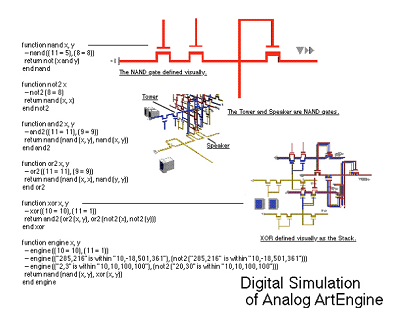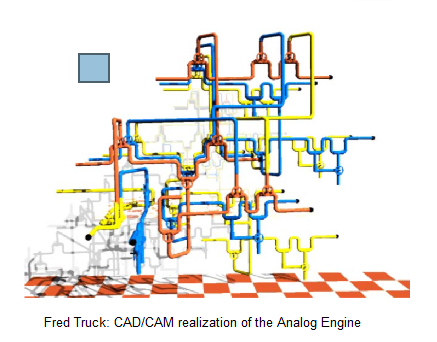
Fred Truck:
Independent Work: 1985 to 1995
Iowa-based artist Fred Truck works in digital, animated 3-D photography and computer arts, as well sculpture, artists books, and graphics designed on a computer. His works range from the 1980 Performance Bank -- created on an Osborne I computer with dBase II and graphics and animations software -- to the animated character Mr. Milk Bottle. They also include the artist's software, ArtEngine. In his words:
"Given two visual objects, and words describing them, the Engine will compare the objects, determine what congruencies there are between them, and then make a new list that creates a new, third visual object..."
In 1986, with Carl Loeffler and San Francisco-based Art Com, Truck was instrumental in the founding of Art Com Electronic Network (ACEN), a pioneering artist's computer network, which ran 24/7 for 13 years. 1 Truck implemented ACEN on The WELL, integrated The WELL's PicoSpan-based conferencing system into ACEN, programmed and implemented the interactive ACEN DataNet Artworks online publishing platform, and formatted John Cage's The First Meeting of the Satie Society for publication on DataNet.
 Although much of Fred Truck's work as an individual artist is not precisely networked, its inclusion in Networked Projects in the Formative Years of the Internet is important because of its parallel with his core role in ACEN and relatedly, the importance of arts-centered networks in the creation of the digital arts. For instance, Fred was a central participant in the ACEN "Software as Art" topic, where in addition to his ArtEngine, discussions centered on other works by individual artists, such as Robert Edgar's Memory Theatre, Judy Malloy's generative hypertext its name was Penelope, Jim Rosenberg's spatial hypertext, Joe Rosen's physical computing works, and Abbe Don's HyperCard-based We Make Memories.
Although much of Fred Truck's work as an individual artist is not precisely networked, its inclusion in Networked Projects in the Formative Years of the Internet is important because of its parallel with his core role in ACEN and relatedly, the importance of arts-centered networks in the creation of the digital arts. For instance, Fred was a central participant in the ACEN "Software as Art" topic, where in addition to his ArtEngine, discussions centered on other works by individual artists, such as Robert Edgar's Memory Theatre, Judy Malloy's generative hypertext its name was Penelope, Jim Rosenberg's spatial hypertext, Joe Rosen's physical computing works, and Abbe Don's HyperCard-based We Make Memories.
In the essay below, Truck sets forth his independent artwork from approximately 1985 to 1995, including how his work with artificial intelligence software led to 3D graphics, his VR work with Leonardo da Vinci's Flying Machine, the Analog Engine, which evolved from the ArtEngine, and Bottega, a digital realization of an artistís workshop. Then, in two attached essays, he documents Arts Engine, Memory Device, and the Analog Engine sculpture.
Fred Truck's work is included in the collections of the Jean Brown Archive in the Getty Museum, The Museum of Modern Art, the Ruth and Marvin Sackner Archive of Concrete and Visual Poetry, die Staatsgalerie Stuttgart, Germany, and the University of Iowa. He has also shown his work internationally at, among others, the Des Moines Art Center, Steven Vail Galleries, Tacoma Art Museum, Museum of Modern Art, Fundacio La Caixa, Spain, and the Banff Center for the Arts, Alberta. Additionally, ArtEngine was included in the Art†Com Software: Digital Concepts and Expressions exhibition, which began at Tisch†School of the Arts, New York University, in 1988 and traveled to†San Jose State University, the University of Colorado, ARS Electronica, and Carnegie Melon University.
His computer-generated bio begins:
"Fred Truck "is an artist who works in a variety of media. By choosing mainly formal solutions, Truck often creates work using creative game tactics, but these are never permissive. Play is a serious matter: during the game, different rules apply than in everyday life and even everyday objects undergo transubstantiation."
__________________________________
1. Judy Malloy, "Art Com Electronic Network: a Conversation with Fred Truck and Anna Couey", in Judy Malloy, ed, Social Media Archeology and Poetics, 2016, pp. 191-218.
Fred Truck
Introductory Essay: Independent Work: 1985 to 1995

M y work with the Art Com Electronic Network (ACEN, 1984-1999) was collaborative. While I was doing that, I felt the need to do my own individual work, which I planned to be separate and distinct from ACEN.
ArtEngine, a piece of artificial intelligence software that used logic to create a synthesis, was my major work during this time period. I began it in 1986, and finished it in 1991. At the same time, I wrote essays concerning the Engine which appeared in ACEN's electronic publication, Art Com Magazine, so there was some overlap.1,2,3 But the software remained mine from inception to execution.
While I was working on the Engine, I became interested in 3D graphics on personal computers. I bought a piece of software called Swivel 3D, written by Jaron Lanier. I loved it and spent a lot of time working with it. My first successful project was an animated 3D realization of Leonardo da Vinci's Flying Machine. It flapped its wings and flew across the monitor.
At the time I did the Flying Machine, I had no idea such graphics could be used for virtual reality. That became evident at the Banff Centre for the Arts, where Carl Loeffler, my partner in ACEN, and I shared a fellowship. We were part of the Bioapparatus Seminar, which studied how digital might affect the physical organism of the human being in the near future. Part of this seminar focused on virtual reality using the Sense8 virtual reality system. I did a reduced materialization of the Flying Machine in virtual reality. It didnít move, but was a virtual sculpture you could walk around.
Later, Carl Loeffler became a fellow at Carnegie Mellon's Studio for Creative Inquiry. He focused on virtual reality, and invited me to come to CMU and finish my Flying Machine project, which I did in 1991.
In 1993, I showed my Flying Machine project at the SIGGRAPH 1993 Machine Culture art show. By this time, the Flying Machine had morphed into an environment. I called the new virtual environment Labyrinth, after the prison on Knossos the mythical engineer Dedalus built, and then was imprisoned in with his son, Icarus. The pilot of my flight simulator could also try to fly to freedom..
Soon afterwards, I began working on my book,
Archaeopteryx, which outlined ambitious plans for a flight simulator based on my experiences with
 S
imultaneously, I was working on 3D graphics that would make the core routines of ArtEngine visible, and possibly physical. In 1991 or thereabouts, I discovered that computer engineers had a system of symbols with which logic gates could be represented. Using the NAND gate, I found I could represent the logic core of Art Engine in a direct and simple manner. Connecting all the NANDs gave me an intriguing graphic at the least and a design for a potential sculpture. Although it would be 10 years before I was able to do this, I began the design.
S
imultaneously, I was working on 3D graphics that would make the core routines of ArtEngine visible, and possibly physical. In 1991 or thereabouts, I discovered that computer engineers had a system of symbols with which logic gates could be represented. Using the NAND gate, I found I could represent the logic core of Art Engine in a direct and simple manner. Connecting all the NANDs gave me an intriguing graphic at the least and a design for a potential sculpture. Although it would be 10 years before I was able to do this, I began the design.
S oon after designing the sculpture, I began to search for ways to sum up my artistic experiences. The artist's workshop theme was current at that time, and it interested me because of its long history in the works of other artists. I designed a workshop I eventually called Bottega, that included Labyrinth, Analog Engine and a number of other elements, such as a desk and monitors of various sizes. Bottega also featured a digital version of Mu'chiís Six Persimmons. Embedded in each persimmon was a realization of Analog Engine -- making a synthesis between the spontaneity of Zen ink painting and the determinism of digital processes.
 Bottega was arranged hierarchically, with the Flying Machine high up and the desk of the artist at the bottom. Visually, it cohered because of a complete lack of gravity and a dream-like atmosphere.
Bottega was arranged hierarchically, with the Flying Machine high up and the desk of the artist at the bottom. Visually, it cohered because of a complete lack of gravity and a dream-like atmosphere.
Two essays are attached as pdfs to this introduction. They are:
Fred Truck, "ArtEngine"
Fred Truck,
"Analog Engine and Memory Device"
__________________________________
1. Fred Truck, "The Electronic Notebook", Art Com Magazine, Issue 4, 1987
2. Fred Truck, "Two Myths," Art Com Magazine, Issue 5, 1989
3. Robert Edgar and Fred Truck, "Two of a Kind: Electronic Interviews and Casual Conversations Among Themselves," Art Com Magazine, Issue 6, 1990
4. Fred Truck, Archaeopteryx. Des Moines, Iowa: F. Truck, 1992.

Networked Art Works: in the Formative Years of the Internet
Judy Malloy: Introduction
Early Telematic Projects
Interview with Tom Klinkowstein
Poietic Generator
Interview with Olivier Auber
Marcello Aitiani: Nave di Luce (Ship of Light)
Nancy Paterson: Stock Market Skirt
Projects Nurtured in Online Conferences
Fred Truck: Independent Work: 1985 to 1995
Robert Edgar: Memory Theatre One
Anna Couey and Judy Malloy:
The Arts Wire Interactive Art Conference
Reviews
Review in retrospect:
Heidi Grundmann's Art Telecommunication
Review: Serge Guilbaut, Joni Low, and Pan Wendt:
Hank Bull: Connexion
Networked Art Works in the Formative Years
of the Internet is an
ongoing supplement to
the MIT Press Book:
Social Media Archeology and Poetics
